NVIDIA Shield Review: At the Crossroads of PC and Mobile Gaming
by Brian Klug on July 31, 2013 12:14 AM ESTGPU Performance - 3DMark
The GPU performance story is finally a competitive one for NVIDIA. Although Tegra 4 lacks full OpenGL ES 3.0 compliance, it does finally dedicate enough SoC die area to GPU performance to compete with the likes of Apple and the iPad with Retina Display. We'll start with 3DMark, which is Android and Windows only at this point.
3DMark for Android features the Ice Storm benchmark and uses OpenGL ES 2.0. Ice Storm is divided into two graphics tests and a physics test. The first graphics test is geometry heavy while the second test is more pixel shader intensive. The physics test, as you might guess, is CPU bound and multithreaded. The overall score takes into account both graphics and physics tests. The benchmark is rendered to an offscreen buffer at 720p/1080p and then scaled up to the native resolution of the device being tested. This is a very similar approach we've seen by game developers to avoid rendering at native resolution on some of the ultra high resolution tablets. The beauty of 3DMark's approach here is the fact that all results are comparable, regardless of a device's native resolution. The downside is we don't get a good idea of how some of the ultra high resolution tablets would behave with these workloads running at their native (> 1080p) resolutions.
Here we see Tegra 4 in Shield outperforming all of the shipping players on Android, and virtually tying with Adreno 330 in Qualcomm's upcoming MSM8974 (Snapdragon 800 platform). Tegra 4's GPU performance is still no where near even Intel's HD 4000, but we're seeing massive improvements in raw FP throughput in ultra mobile GPUs. I'm very eager to see what's possible once Kepler makes its way into NVIDIA's mobile SoCs next year with Logan.
The 3DMark Physics test is also worth looking at as it shows a 36% increase in performance over four Krait 300 cores running at 1.5GHz. There are faster Krait 300s out there, but another 13% isn't enough to make up this gap. The Krait 400 comparison is much closer, but the Krait 400s have to be clocked at 2.3GHz to equal the performance of the 1.9GHz Cortex A15s. It remains to be seen which combination is ultimately lower power.
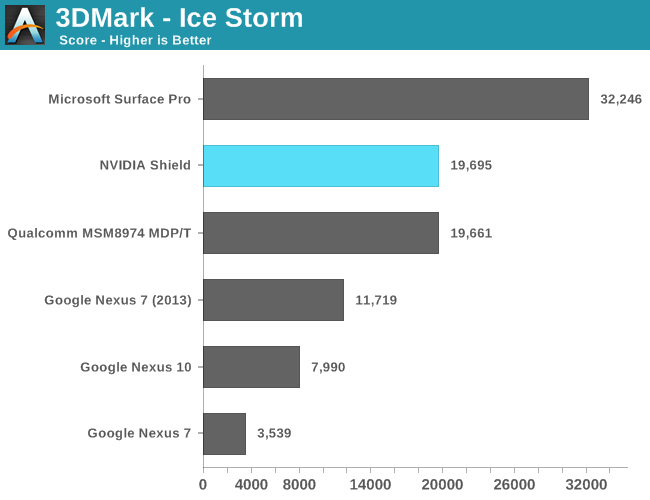

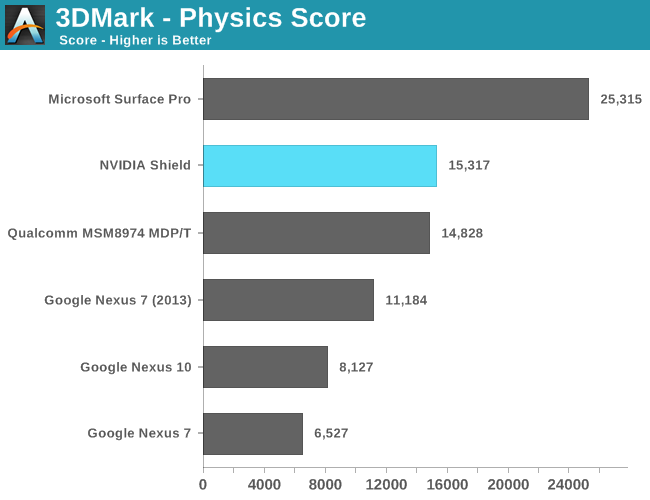
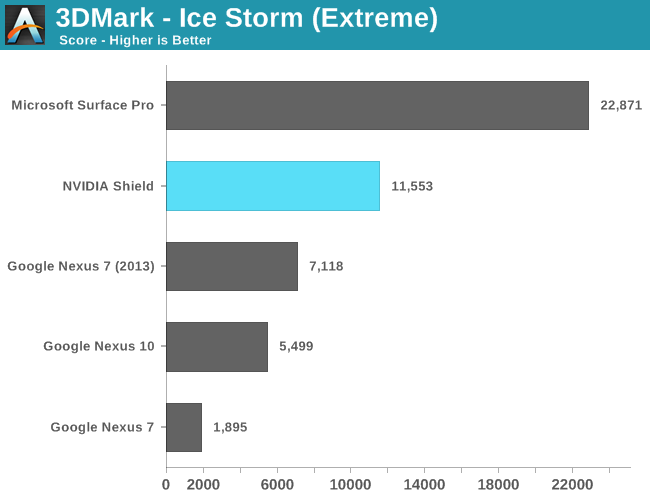
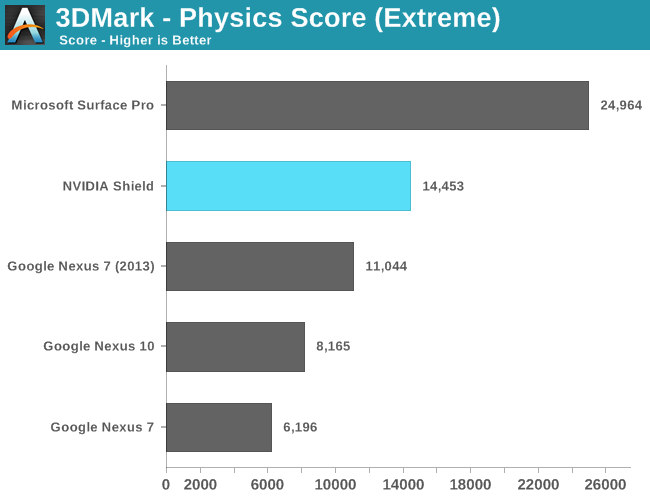

Basemark X
Basemark X is a new addition to our mobile GPU benchmark suite. There are no low level tests here, just some game simulation tests run at both onscreen (device resolution) and offscreen (1080p, no vsync) settings. The scene complexity is far closer to GLBenchmark 2.7 than the new 3DMark Ice Storm benchmark, so frame rates are pretty low.
In both tests, NVIDIA posts big gains over anything presently shipping from the Android camp. Adreno 330 pulls ahead on a level playing field, holding a 24% performance advantage over Tegra 4.
I would've loved to have seen this sort of competition from NVIDIA back when the iPad 4 launched, but it's at least good to see NVIDIA move from being a value player with Tegra 3 to a high performance contender with Tegra 4.
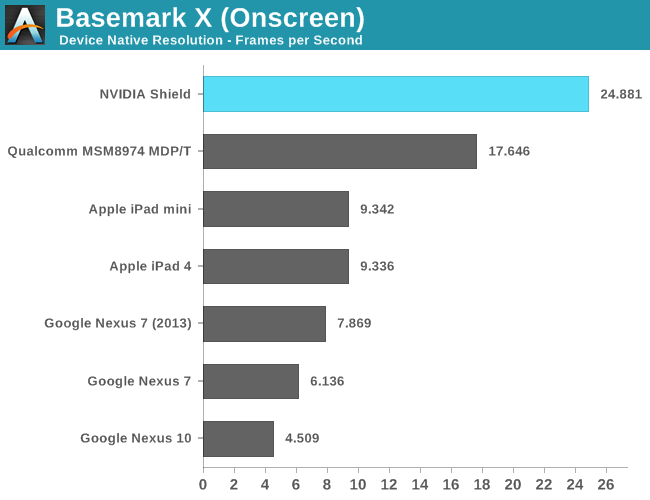











134 Comments
View All Comments
ChronoReverse - Wednesday, July 31, 2013 - link
I won't comment on the Ouya but it's not really true that the Shield has the CPU power to go beyond existing Android platforms.The Shield still doesn't have sufficient power to emulate the PS2 so it's limited to PSP, DS and N64 class emulation.
But the Snapdragon Pro already has sufficient power to emulate those at full speed (in fact, it's insufficient software optimization that holds back emulation performance). Actually even quad A9's can do it.
So the Shield is stuck at a halfway point where it doesn't offer greater emulation capabilities despite being more powerful.
fr33h33l - Wednesday, July 31, 2013 - link
Your comment seems contradictory to the CPU Performance section in the review, e.g. than not even Snapdragon 800 (itself significantly faster than Snapdragon Pro) can keep up with Tegra 4 in terms of CPU performance. Care to elaborate on your claims?Arbee - Wednesday, July 31, 2013 - link
Yes and no - it can do the existing platforms at a much higher degree of fidelity than the existing emulators, and it can run (ARM ports of) the best-of-breed PC emulators for those systems like bsnes and so on. It can run real current MAME instead of the gimpy circa-1999 "4All" version, it can run bsnes/higan instead of snes9x, and NEStopia instead of I don't know what. That in itself is a great upgrade for accuracy snobs like me, and then combine it with decent controls and it's great.I agree that a similar device with a Snapdragon Pro or Apple A6 wouldn't give away much in the performance department, but nobody's making one. Meanwhile, FedEx just showed up with my Shield :)
mamisano - Wednesday, July 31, 2013 - link
Sorry if I missed it, what are the minimum hardware requirements for the gaming PC to stream to Shield? You used a pretty beefy system that is definitely not representative of the average rig out there.PNN - Wednesday, July 31, 2013 - link
Nvidia GTX 600 series or newer is required.ssiu - Wednesday, July 31, 2013 - link
Pretty beefy hardware required. From http://shield.nvidia.com/play-pc-games> GPU: GeForce GTX 650 or higher desktop GPU (Notebook GPUs are not supported at this time)
> CPU: Intel Core i3-2100 3.1GHz or AMD Athlon II X4 630 2.8GHz or higher
> System Memory: 4GB or higher
> Software: GeForce Experience™ application and latest GeForce drivers
> OS: Windows 8 or Windows 7
> Routers: 802.11a/g router (minimum). 802.11n dual band router (recommended).
Roland00Address - Wednesday, July 31, 2013 - link
Apple has trademark the term Retina Display. Thus nvidia can not use itspigzone - Wednesday, July 31, 2013 - link
Likely developed as in in house remote terminal for the Steam Box, where it would actually make sense, it's release into the wild indicates Nvidia ultimately lost to AMD to provide that hardware, likely due to publisher/developer pressure to go with a console compatible solution an AMD HSA APU that they could port to easily and cheaply.chizow - Wednesday, July 31, 2013 - link
Looks like an impressive first effort by Nvidia, especially since it's almost 100% home-grown. Not interested in it for my own user however, not yet anyways, for the reasons below:1) Android gaming market just isn't enough on it's own to justify this for me. Phone and tablet are enough atm for minor gaming on my mobile devices.
2) I did not see any mention of this being used as a Windows Media Extender. If this were able to function as a streaming device, even for DLNA compatible devices, that would be a huge plus for SHIELD. It already has the mini-HDMI output and wireless capabilities, would just need the software.
3) PC streaming to local network connection is nice, but if this could be expanded to remote locations with sufficient network connectivity, I'd be sold instantly.
Overall I think Nvidia is building an impressive track record with their in-house hardware designs, I'm really hoping Shield does well enough that it warrants a 2nd iteration and improvements, but right now, I'm really not sure what it's future holds for many of the reasons cited in the article.
Arbee - Wednesday, July 31, 2013 - link
There are DLNA applications for Android in the Play Store. I don't know how well they function, but perhaps one or more of them might work for you. Alternatively, if you run the Plex media server, their Android app *is* good.